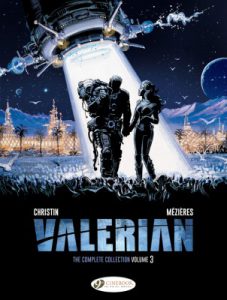Looking for a “Valerian” fix after last year’s movie, “Valerian and the City of a Thousand Planets,” I’m delving into the comics that started it all, by Frenchmen Pierre Christin (writer) and Jean-Claude Mezieres (pencils and inks). “The Complete Collection, Volume 3” includes “Ambassador of the Shadows” (1975), “On the False Earths” (1977) and “Heroes of the Equinox” (1978).
Volume 6: “Ambassador of the Shadows” (1975)
This seventh “Valerian” entry (the first volume is No. 0) is now the most famous one thanks to Luc Besson adapting it into the 2017 movie “Valerian and the City of a Thousand Planets.” It’s not a straight adaptation, but it’s more than merely inspired by the comic. Besson follows “Ambassador’s” structure, with our heroes serving as bodyguards to the Earth ambassador, who is apprehended by a mysterious race in the massive space station Point Central (renamed Alpha in the movie). Laureline then pursues Valerian and the ambassador, using a cute little animal called a transmuter (renamed a converter in the movie) to reproduce valuables in order to pay for information.
Besson improves on C&M’s work in two notable ways. First, he emphasizes the V&L relationship. By this time in the comics, V&L are a couple, as happy reunions always include kisses and they call each other “my Valerian” and “my little Laureline.” But Christin never did write one of those “now they are a couple” stories that are the backbone of modern TV serials. Besson fills in that gap.
Second, Besson makes the Pearls (who in the comic are unnamed and live on The World Without a Name) into clear victims of an Earth general’s warmongering. Although the anti-imperialism theme is the same, this arc plays less dramatically in the comic, where the supernaturally persuasive (and somewhat preachy) race simply replaces the ambassador’s ambitions with an urge for peace.
Although I favor the movie script, “Ambassador” is still one of the elite “Valerian” comics. Point Central is a brilliant locale, wonderfully demonstrating that free trade can work (and indeed works better) without the heavy hand of government. It’s also the first story with Laureline in the lead, and she’s utterly confident in the role, in stark contrast to meek tagalong Colonel Zuur, whom she derisively calls “Colonel Protocol.”
C&M’s imaginations shine, notably with the funny transmuter arc: The creature gets more tired each time he poops out copies of valuables, capped with the punchline where Laureline diverts the ship’s power to re-energize her cute pet. Some of Laureline’s wild experiences are repurposed for Valerian in the movie, but filmgoers will remember our hero(es) combining forces with a shapeshifter, donning a giant jellyfish like a hat in order to absorb its memories, and dealing with the exasperating, information-selling Shingouz trio, who I suspect inspired the Squibs in Troy Denning’s “Star Wars” books.
All told, Besson made an excellent choice for the first film adaptation.
4.5 stars
Volume 7: “On the False Earths” (1977)
This is a dropoff from the previous entry; I’d go so far to give it the underhanded insult of being an interesting failure. In a story that will seem familiar to fans of the TV series “Westworld,” Valerian continually “dies” on missions throughout Earth’s history. Laureline is disturbed but not torn up by this, and commanding officer Jadna isn’t bothered at all. C&M reveal that these are clones several pages after I had figured it out, and I’m not usually ahead of the curve when reading “Valerian.”

Jadna’s obsession with meeting (rather than apprehending) the genius who is creating these false Earths is also telegraphed. And the stakes seem low, since the genius – albeit mad, and albeit another thought-blob (smaller than the one in “Birds of the Master”) – is no threat to anyone.
I like the verisimilitude provided by the fact that the clones can function as believable humans for only a short time, and the fact that Valerian’s energy is being drained by the clones. Still, C&M seem less committed to this idea than to others. Is it because the “Westworld” movie beat them to the punch by a few years?
3.5 stars
Volume 8: “Heroes of the Equinox” (1978)
This one is even more of a drag. For the third straight story, V&L are separated; it worked great the first time, but now I long to see them working together again. On the planet Simlane, Laureline can only worry as Valerian goes through trials as the Earth representative in a series of tests reminiscent of “Harry Potter and the Goblet of Fire.”
Unusual for C&M, the trials are not particularly creative – the four champions survive harsh environments and fight a few monsters (although art fans will note that this is Mezieres’ first venture into multi-page spreads and larger splash panels). In the end, the judge asks them to explain their political philosophy; Valerian’s is the only one that doesn’t involve controlling people. Although I can’t scoff at a story where the free-trade viewpoint defeats that of the communist, the militarist and theocrat, the four philosophies aren’t worked into the characters’ trials in a meaningful way.
The ending is weird. When Laureline is reunited with Valerian, he is for some reason super-small-sized. Full-body shrinkage had happened to Laureline way back in “Bad Dreams” (although it’s not referenced here), but she gradually regrows to normal size in that story. Valerian doesn’t, and Laureline acts unconcerned as a way of lightly punishing him for his promiscuity. (In his defense, he is required to procreate with a goddess as the winner of the Simlane competition. On the other hand, he doesn’t protest much: “Oh, well, if it’s for a good cause …”). Similar to “Birds of the Master,” “Equinox” ends with a punchline (Valerian’s small stature) that could’ve been a springboard to another story, but probably won’t be.
3 stars
Click here for a complete index of “Valerian and Laureline” reviews.

